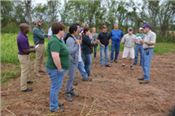Cover Crops Offer Farmers Benefits

LSU AgCenter corn cotton specialist Dan Fromme talks about a series of research
plots at the Dean Lee Research Station to evaluate the use of cover crops with
corn in Louisiana growing conditions. Fromme also has a cover crop research
project on a corn field in Beauregard Parish.
Photo by Bruce Schultz
ALEXANDRIA, LA.
LSU AgCenter researchers at the Dean Lee Research and Extension Center are studying the use of cover crops, which are grown in the off-season for erosion control, improved fertility and an increase in organic matter in the soil.
“Overall, the research showed us there was a good increase in yield,” LSU AgCenter economist Naveen Adusumilli said at a cover crop field day at the Dean Lee Research Station on April 6.
Yields increased by as much as 20-30 percent in the first year of testing cover crops grown in the winter before cotton, he said.
AgCenter corn specialist Dan Fromme said he will be testing cover crops with corn at a farm in Beauregard Parish using crimson clover, tillage radish and rye to see what advantages can be realized. He also has a series of cover crop research plots at the Dean Lee Research Station.
Chris Coreil, with the USDA Natural Resources Conservation Service, said money is available to help farmers use cover crops up to five years. He said it may take longer than three years to see any benefit to using cover crops, and yields may even decline for the first two years.
“You are trying to adjust the soil ecosystem with a cover crop,” Coreil said.
The roots of tillage radishes won’t grow through a hard pan soil layer, he said.
The NRCS will pay $50 to $70 per acre to help farmers try cover crops, but he advised farmers to start with a small acreage.
Cover crops are planted in the fall after harvest and have to be killed before the subsequent main crop is planted. In northern states, cover crops are killed by freezing weather, but Louisiana farmers have to use herbicides because of the warmer weather.
AgCenter weed scientist Daniel Stephenson said testing of several herbicides on tillage radish showed that a combination of glyphosate and 2,4-D herbicides showed the best results.
Herbicides should be applied four to six weeks before a crop is planted to eliminate the food source for insects that could become pests on the main crop, he said.
Tillage radish that goes to seed becomes more difficult to kill, he said.
AgCenter soil microbiologist Lisa Fultz said the cover crop project includes a study of how cover crops may benefit soybean production by adding nutrients to the soil.
AgCenter area agent Donna Morgan said the studies will provide information for using cover crops in Louisiana’s unique growing conditions. “There are a lot of things we don’t know,” she said. ∆